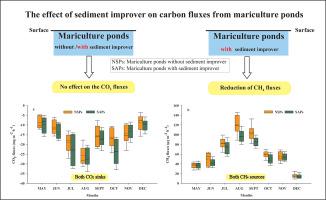Science of the Total Environment ( IF 8.2 ) Pub Date : 2022-03-18 , DOI: 10.1016/j.scitotenv.2022.154610 Dongxu Zhang 1 , Jie He 1 , Wenjun Xu 1 , Shuang Li 2 , Huiling Liu 3 , Xinru Chai 3

|
The CO2 and CH4 fluxes across the water-air interface were determined in two groups of swimming crab (Portunus trituberculatus)-ridgetail white prawn (Exopalaemon carinicauda) polyculture ponds. One group of ponds with sediment improver application were referred to as SAPs, and the other group receiving no sediment improver were as NSPs. During the farming season, both the SAPs and NSPs acted as CO2 sinks and CH4 sources. The cumulative CO2-C fluxes from the SAPs and NSPs were −26.78 and −23.49 g m−2, respectively, and the cumulative CH4-C emissions from the SAPs and NSPs were 0.24 and 0.28 g m−2, respectively. CO2 fluxes were significantly related to net primary production and water pH, and CH4 fluxes were mainly regulated by water temperature during the farming season. The application of the oxidation-based sediment improver had a positive effect on reducing the CH4 emissions across the water-air interface but had no effect on CO2 fluxes. The sediment improver reduced the organic matter contents and improved the sediment pH and redox potential, which may have facilitated a decrease in CH4 production in the sediment. The CO2 produced through the oxidation of organic material in the sediment may have been absorbed by strong photosynthesis, resulting in a nonsignificant difference in CO2 fluxes between the SAPs and NSPs. The results indicated that the application of sediment improvers in coastal polyculture ponds can reduce carbon emissions, especially CH4 emissions, during the farming period and could help mitigate global warming with regard to the sustained-flux global warming potential (SGWP) and sustained-flux global cooling potential (SGCP) models over a 20-year time horizon. Future studies on the CO2 and CH4 production rates of the sediment and the related microbial community could improve our understanding of the effect mechanism of the application of sediment improvers on CO2 and CH4 emissions from mariculture ponds.
中文翻译:

海水养殖池塘的二氧化碳和甲烷通量:沉积物改良剂减少碳排放的潜力
在两组游泳蟹(Portunus trituberculatus)-脊尾白对虾(Exopalaemon carinicauda)混养池中测定了穿过水-空气界面的CO 2和CH 4通量。使用沉积物改良剂的一组池塘称为 SAPs,另一组未使用沉积物改良剂的池塘称为 NSPs。在耕作季节,SAP 和 NSP 都充当 CO 2汇和 CH 4源。SAPs和NSPs的累积CO 2 -C通量分别为-26.78和-23.49 gm -2,SAPs和NSPs的CH 4 -C累积排放量分别为0.24和0.28 gm-2,分别。CO 2通量与净初级产量和水体pH值显着相关,CH 4通量主要受农季水温的调节。基于氧化的沉积物改良剂的应用对减少通过水-空气界面的CH 4排放具有积极作用,但对CO 2通量没有影响。沉积物改良剂降低了有机质含量,提高了沉积物的 pH 值和氧化还原电位,这可能有助于减少沉积物中 CH 4的产生。CO 2沉积物中有机物质氧化产生的物质可能已被强光合作用吸收,导致 SAP 和 NSP 之间的 CO 2通量差异不显着。结果表明,在沿海混养池塘中应用沉积物改良剂可以减少养殖期间的碳排放,尤其是 CH 4排放,并有助于缓解全球变暖的持续通量全球变暖潜势(SGWP)和持续通量20 年时间范围内的全球冷却潜力 (SGCP) 模型。CO 2和 CH 4的未来研究沉积物和相关微生物群落的生产率可以提高我们对沉积物改良剂应用对海水养殖池塘CO 2和CH 4排放的影响机制的理解。











































 京公网安备 11010802027423号
京公网安备 11010802027423号